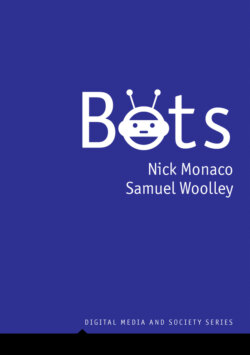Читать книгу Bots - Nick Monaco - Страница 17
Social media and the dawn of social bots
ОглавлениеSocial media supercharged bot evolution in the late 2000s. During this period, the cost of broadband internet declined, connectivity increased, and computing power grew. A growing number of people began to spend more and more time on social media sites, producing their own content. The entire web began to evolve, shifting from a slow, company-driven, rocky experience to a smoother, sleeker, and user-friendly one in which user-generated content took the foreground. This new user-centric version of the internet came to be known as the “web 2.0” (O’Reilly, 2005).
The user-friendly and user-centric web 2.0 had its own problems. Just as advertisers had realized in the 1990s that the World Wide Web was a new revolutionary opportunity for marketing (and sometimes spam), in the 2000s governments and activists began to realize that the new incarnation of the web was a powerful place to spread political messages. In this environment, political bots, astroturfing, and computational propaganda quickly proliferated, though it would take decades for the wider public to realize it (Zi et al., 2010). We’ll examine these dynamics in greater detail and depth in our chapters on political bots and commercial bots.
In every case, online environments that are welcoming to bot innovations – Usenet, IRC, or MUD-gaming platforms in the late 1980s and early 1990s, or Twitter in the late aughts – have consistently been strong drivers of bot evolution. The design of these environments, called their platform architecture, is just as important as their policies on bots. In MUD gaming environments, users could easily access and modify code to build bot characters in the game; in IRC and Usenet, bots were a necessary infrastructural part of interacting with the platform, and users often enjoyed building their own. Similarly, early 2000s virtual worlds like Second Life were designed in such a way that bot development became more accessible for average users (Lugrin et al., 2008). Now, perhaps most significantly for the era of social media, Twitter’s infrastructure is extremely welcoming to bots (and was even more so in the platform’s early days) (Ferrara et al., 2014; Zi et al., 2010). Twitter’s Application Programming Interface (API) makes building and connecting bots to the platform easy, and its infrastructure has arguably done more to democratize bot development and drive their evolution than any other platform or website in bot history.
